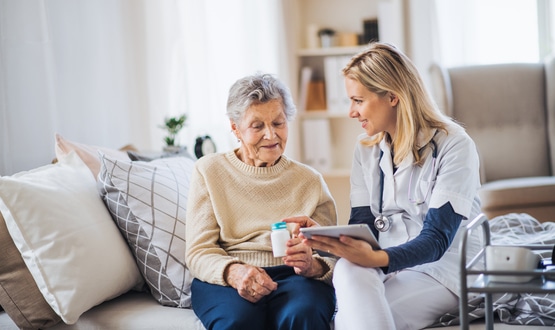Digital Networks: virtual wards require enthusiastic and engaged leaders
- 7 August 2023

The introduction of virtual wards, which is already accelerating across the country, requires the involvement of enthusiastic and engaged leaders for success, speakers told attendees at a recent Digital Health Networks Exchange event.
The exclusive Networks event on Virtual Wards heard from the leaders of seven different Virtual Wards projects, ranging from a virtual COPD ward in Hull through to an acute virtual ward in Manchester, as well as remote monitoring projects to manage blood pressure in Leeds midwifery patients and frailty in Sheffield.
Dr. Janet King, regional director of digital transformation, North West, for NHS England, told the audience in Leeds that there should be a continuum between virtual care and self-care, creating an interactive dynamic between patients and the health system. Within this loop, self-referral, automated triage and algorithms can help support emergency care services.
She said: “We do not have the workforce we need. That is unlikely to change in the short-term, so how do we use some of this virtual technology to help increase capability?”
Doing so will require a broad look at data and standards and the way in which virtual care should fit into the overall healthcare system. Health providers will also need to give patients “the confidence that someone will notice and act” if they are being monitored from afar, King added.
In northwest England – where some 44 virtual wards are already treating patients with respiratory conditions, heart failure, frailty, cancer, and paediatric illnesses among others – clinical networks are already beginning to talk about how virtual care is integrated into overall service delivery and how it can be made sustainable, King said. Collecting evidence that virtual care is clinically effective and justifies further funding for test projects will be crucial.
Need to avoid overcomplication
Another speaker emphasised the need to ensure that equipment is user-friendly, interoperable and focused on making the job of clinicians easier.
“If you are creating user interfaces that require a day of work to learn how to use them, that’s probably not the right system,” Dr Simon Eccles, former national chief clinical information officer (CCIO) and vice president and chief health officer, EMEA at Salesforce, told participants.
AI clearly has a role to play in reducing the burden of data interpretation, he added, and some rules will need to be streamlined (“If you ordered the test, you are responsible for checking the test”) but clinical structures will need to be adapted to allow for more collaborative models of care and remove organisational boundaries.
At the same time, Eccles observed that as virtual wards erase the dividing line between hospitals and community care, acute providers will require more training in the community.
A work in progress
Several speakers presented case studies tracking virtual ward and remote monitoring programs, detailing both progress in gaining the confidence of patients and challenges posed by technology and organisational obstacles.
Alistair Pickering, CCIO of Hull University Teaching Hospitals NHS Trust, said Hull’s respiratory and COPD virtual wards have benefitted from a proactive team and ability to work with an external third-party digital partner that supported wearables, enabling it to offer “a lot more than we could support with our internal system”.
The Hull team takes time to understand a patient’s level of digital literacy and help them understand how the monitoring process work, and while they still sometimes struggle to get patients to buy into sustained use of digital products, they are helping to empower patients, Pickering said.
He adds: “We are early in our journey, but we feel we are heading in the right direction, excited about what opportunities there are over the next 12-18 months.
“The next step is to start looking at some of the additional features the platform offers: data analytics, risk prediction and the ability for patients to understand a bit more about their condition.”
Meanwhile, although many trusts are implementing virtual wards for patients who are likely to be fairly straightforward to manage outside the hospital, at least one has used the wards to treat patients with the most complex needs.
Karl Guttormsen, an advanced clinical practitioner and interim acute virtual ward lead at North Manchester General Hospital and Abby Barlow, a clinical nurse specialist at Manchester University NHS Foundation Trust, described using the virtual ward to manage a 27-year-old non-verbal, bed- or chair- bound woman with multiple medical conditions, including multiple allergies, a gastronomy tube and PEG site infections.
The patient had averaged 11 emergency department visits in the six months before her admission to the virtual ward, which she and her family had found distressing.
“On the virtual ward, she had ongoing temperature spikes, but we were able to review her bloods and observations and put her on regular nebulisers,” Barlow said. “She spent an average of seven days on the virtual ward, but it helps to avoid her coming back.”
In addition to the more intensive care provided on virtual wards, speakers described less intensive projects, including a Leeds programme designed to monitor blood pressure in pregnant women and one in Sheffield for monitoring frailty in patients discharged from hospital.
In both cases, programs aim to reduce the burdens face-to-face appointments put on patients as well as helping to involve family and carers.
Expanding the use of virtual wards will require trusts to optimise their use as carefully as possible in order to attract the investment they need, speakers said. In addition, they will need to find the right leadership to make it happen.
“It needs a super enthusiastic team to get it started,” Eccles said. “Each locality needs to find its enthusiastic team.”
Last month, NHS England chief executive Amanda Pritchard announced that tens of thousands of children will benefit from the expansion of virtual wards, seeing them receive hospital-level care from their own homes.




